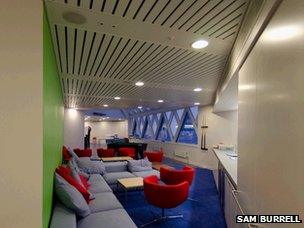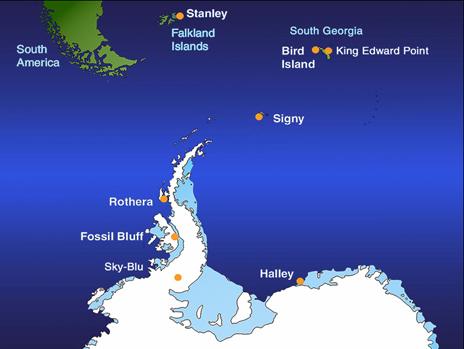Halley Antarctic research station up and running
- Published
Architect Hugh Broughton on how Halley VI was built in extreme conditions
Britain's new Halley research station in the Antarctic goes into full operation this month.
The base sits on the Brunt Ice Shelf, and is the sixth such UK facility to be erected at this location since 1957.
Together with Rothera on the Antarctic Peninsula, it will spearhead UK science on the White Continent.
Halley gathers important weather and climate data, and it played a critical role in the research that identified the ozone "hole" in 1985.
In recent years, Halley has also become a major centre for studying solar activity and the impacts it can have on Earth.
This is most evident in the beautiful auroras that form over the base - the consequence of particles from the Sun crashing into air molecules high in the atmosphere.

Inside the new Halley: All mod cons
Halley VI's researchers now have a state-of-the-art complex from which to monitor these phenomena.
Perhaps the most striking thing about the new station is its appearance.
"It looks like something in space," says architect Hugh Broughton.
The British Antarctic Survey (BAS) station comprises eight modules in all. The seven blue ones are work and habitation units. The central red module, which is on two storeys, is the social hub where residents can gather to relax. It contains the dining room, the bar and even a gym.
The entire base stands on a hydraulic leg and ski system that allows it to be raised above the annual snowfall, and periodically to be towed closer to land.
If these adjustments were not to happen, the station would eventually be buried and carried to the ice edge where it would then be dropped into the ocean.

As much as possible was fabricated before arrival in the Antarctic
Halley bases I to IV were abandoned to this fate. The new design makes the adjustments easier and less labour intensive.
The station was constructed in large part in South Africa and then shipped to the Antarctic in easy-to-assemble units.
"The idea was to prefabricate as much as possible," explained Karl Tuplin, the project manager for the Halley VI building programme.
"Room pods, bedrooms, bathrooms - they were all made in advance. Mechanical, electrical services - the wires and piping - came in cassettes that were just slotted into place."
The hope is, some refurbishment notwithstanding, the new Halley can last 30-40 years before a wholly new structure is required.
"The feedback has been great," Mr Broughton told BBC News. "In the last station, not everyone had a window from their bedroom. Now everyone's got a view. The acoustics are better, and there're more opportunities to rest. But also the working conditions are much better and there's a far greater array of different scientific experiments now possible at Halley VI compared to Halley V."
The old station has just been dismantled and all its parts removed from the Antarctic.

The British Antarctic Survey operates a number of research stations and forward supply facilities
Jonathan.Amos-INTERNET@bbc.co.uk and follow me on Twitter: @BBCAmos, external
- Published2 November 2012
- Published18 December 2012